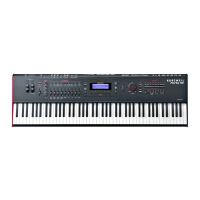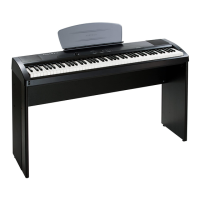Program Edit Mode
The Arpeggiator Function
7-60
Unipolar means that after playing up to the shift limit, the Arpeggiator begins shifting
notes in the opposite direction, until it reaches the original pitch, where it reverses again.
To determine the next note when it reaches the shift limit, the Arpeggiator calculates the
interval between the shift limit and what the next note would be if the shift limit weren’t
there. It then plays the note that is the calculated interval lower than the last note before the
shift limit. e same thing happens in reverse when the arpeggiated notes get back down to
the original pitch. e following table makes this easier to visualize by showing the result of
arpeggiating one note (C4) in Unipolar mode, with Shift Amount set to 3 ST and various
values for Shift Limit.
Shift Limit
Resulting Arpeggiation (When LimitOption is Unipolar)
Comment
Up Down Up
6 ST (F#4) C4, D
#
4, F
#
4, D
#
4, C4 D#4, …
Same notes play in both directions when Shift
Limit is a multiple of Shift Amount
7 ST (G4) C4, D
#
4, F
#
4, E4, C
#
4, D
#
4, …
Last upward note before shift limit is F#4, next
upward note would be A4, which is 2 ST from
shift limit (G4); therefore rst downward note is
E4 (2 ST below last upward note)
8 ST (G
#
4) C4, D
#
4, F
#
4, F4, D4, D
#
4, …
A4 is 1 ST from shift limit, therefore rst
downward note is F4 (1 ST lower than last
upward note)
9 ST (A4) C4, D
#
4, F
#
4, A4 F
#
4, D
#
4, C4, D#4, … All symmetrical again; now A4 is within shift limit
10 ST (A#4) C4, D
#
4, F
#
4, A4, G4, E4, C
#
4, D
#
4, …
Next upward note would be C5, which is 2 ST
from shift limit
11 ST (B4) C4, D
#
4, F
#
4, A4, G
#
4, F4, D4, D
#
4, … C5 is 1 ST from shift limit
12 ST (C5)
C4, D
#
4, F
#
4, A4,
C5,
A4, F
#
4, D
#
4,
C4,
D#4, … Symmetrical again, including C5
Bipolar starts out the same way as Unipolar, but during downward note shifting, it
continues past the original pitch until it hits the shift limit in the opposite direction, where it
reverses again.
Float Rst adds a bit of apparent randomness to the process. “Float” means that when the
Arpeggiator reaches the shift limit, it resets—but not to its original pitch as with Reset.
Like Unipolar and Bipolar, it looks at the rst note that would exceed the shift limit, and
calculates the interval between that note and the shift limit. It then restarts the cycle of notes,
transposing the entire cycle by the interval it just calculated, then shifting each subsequent
cycle by the value of Shift Amount, until it reaches the shift limit again.
Here’s a very simple example. Suppose that the only note in the Arpeggiator cycle isC4,
Shift Amount is4 (a third), and Shift Limit is7 (so notes won’t get shifted above G4). e
Arpeggiator plays C4, then E4. e next note should be G
#
4, but that’s above the shift
limit—so the arpeggiator calculates the dierence between that G
#
4 and the shift limit (G4):

